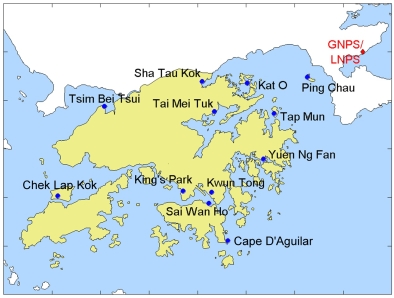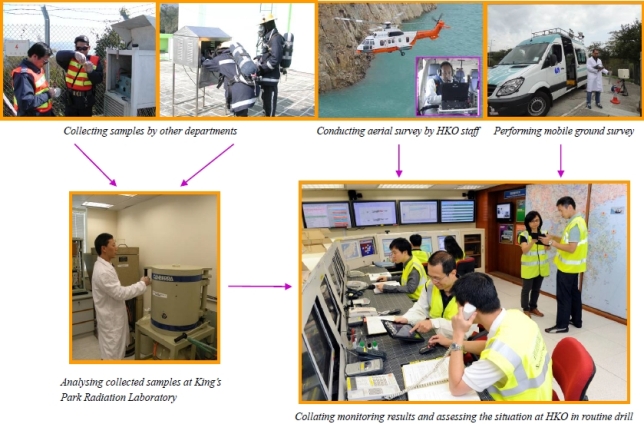Radiation Monitoring and Assessment in Hong Kong
Introduction:
The Hong Kong Observatory (HKO) started measuring radioactivity in 1961 to monitor radioactivity in air which might affect the health of the local population and to determine, as part of an international network, the global atmospheric transport of radioactive dust and other contaminated substances.
Environmental Radiation Monitoring:
In connection with implementation of the Guangdong Nuclear Power Station (GNPS) at Daya Bay, HKO expanded its monitoring activities in the late 1980's to a full-scale Environmental Radiation Monitoring Programme (ERMP). ERMP covers all possible pathways which may expose the population of Hong Kong to increased radiation, namely (a) direct radiation from radioactive materials released into air, (b) direct radiation from radioactive materials deposited on ground surface, (c) inhalation of radioactive materials in air, and (d) ingestion of contaminated food and water. ERMP enables the monitoring of any changes in radiation levels in Hong Kong including those arising from the operation of the GNPS since 1994 as well as its neighbouring Lingao Nuclear Power Station (LNPS), operational since 2002.

Figure 1. Locations of the 12 fixed monitoring stations of the Radiation Monitoring Network in Hong Kong
For direct radiation in the air and from the ground, real-time measurements are undertaken by 12 fixed stations of the Radiation Monitoring Network (Figure 1) which send data back to HKO every minute. Each station is also equipped with various instruments for routine and emergency radiation monitoring. To enable early response, HKO has established an Automatic Gamma Spectrometry System at Ping Chau, the station closest to Daya Bay, to collect air samples and conduct radiation measurements on site. The results are also transmitted to HKO automatically.

Figure 2. Collecting airborne particulate sample by HKO staff
Regarding the monitoring of food and environmental samples, HKO, with the assistance of other government departments, routinely collects representative air, water, soil and food samples (Figure 2) and analyzes them at HKO's Radiation Laboratory at King's Park (Figure 3).

Figure 3. HKO's Radiation Laboratory at King's Park
ERMP monitoring results over the years show that there is no measurable increase in radiation levels in Hong Kong arising from the operation of GNPS and LNPS.
Emergency monitoring and assessment:
In the unlikely event of a nuclear accident at Daya Bay, HKO will step up monitoring of radiation levels in Hong Kong (Figure 4).
In addition to the Radiation Monitoring Network, aerial and mobile ground surveys will be conducted to determine whether Hong Kong is being affected by radioactive substance, and if so, the extent of its spread and whether any parts of the territory have been contaminated.
Aerial surveys are conducted using special radiation equipment on board a Government Flying Service helicopter while mobile ground surveys are carried out using a mobile survey vehicle with measuring equipment on board. All survey data are transmitted back to HKO in real-time. At the same time, additional environmental samples are collected at various sites. The radioactivity in the collected samples is then analyzed at the Radiation Laboratory at King's Park.
In consequence assessment, HKO uses a computer model to simulate the movement and behaviour of the released radioactive materials based on available radiological and weather information. With reference to the assessment results, HKO, in collaboration with the Department of Health and the Electrical and Mechanical Services Department, will then advise the Government on possible radiological impact to the public and the appropriate countermeasures that may be required.
Emergency Preparedness:
To ensure prompt response during an emergency, HKO conducts drills and exercises regularly. Improvement areas identified are implemented. Equipment and communication channels are also regularly tested to ensure they are in a ready state.
Measurement results and Publications :
Hourly readings of radiation levels measured by the Radiation Monitoring Network are available real-time at HKO web site. A summary of these radiation levels is also published monthly while overall measurement results of the ERMP are published annually. All these reports as well as various studies by HKO related to radiation monitoring and assessment can be found in the Observatory web site at https://www.weather.gov.hk/en/publica/pubrm.htm.

Figure 4. Emergency monitoring and assessment of radiation levels in Hong Kong
For more information, please visit the Radiation Monitoring, Assessment and Protection web page.